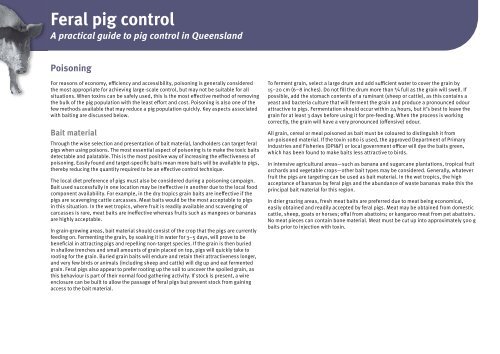Ipa Feral Pig Control Manual - Department of Primary Industries ...
Ipa Feral Pig Control Manual - Department of Primary Industries ...
Ipa Feral Pig Control Manual - Department of Primary Industries ...
You also want an ePaper? Increase the reach of your titles
YUMPU automatically turns print PDFs into web optimized ePapers that Google loves.
<strong>Feral</strong> pig control<br />
A practical guide to pig control in Queensland<br />
Poisoning<br />
For reasons <strong>of</strong> economy, efficiency and accessibility, poisoning is generally considered<br />
the most appropriate for achieving large-scale control, but may not be suitable for all<br />
situations. When toxins can be safely used, this is the most effective method <strong>of</strong> removing<br />
the bulk <strong>of</strong> the pig population with the least effort and cost. Poisoning is also one <strong>of</strong> the<br />
few methods available that may reduce a pig population quickly. Key aspects associated<br />
with baiting are discussed below.<br />
Bait material<br />
Through the wise selection and presentation <strong>of</strong> bait material, landholders can target feral<br />
pigs when using poisons. The most essential aspect <strong>of</strong> poisoning is to make the toxic baits<br />
detectable and palatable. This is the most positive way <strong>of</strong> increasing the effectiveness <strong>of</strong><br />
poisoning. Easily found and target-specific baits mean more baits will be available to pigs,<br />
thereby reducing the quantity required to be an effective control technique.<br />
The local diet preference <strong>of</strong> pigs must also be considered during a poisoning campaign.<br />
Bait used successfully in one location may be ineffective in another due to the local food<br />
component availability. For example, in the dry tropics grain baits are ineffective if the<br />
pigs are scavenging cattle carcasses. Meat baits would be the most acceptable to pigs<br />
in this situation. In the wet tropics, where fruit is readily available and scavenging <strong>of</strong><br />
carcasses is rare, meat baits are ineffective whereas fruits such as mangoes or bananas<br />
are highly acceptable.<br />
In grain-growing areas, bait material should consist <strong>of</strong> the crop that the pigs are currently<br />
feeding on. Fermenting the grain, by soaking it in water for 3–5 days, will prove to be<br />
beneficial in attracting pigs and repelling non-target species. If the grain is then buried<br />
in shallow trenches and small amounts <strong>of</strong> grain placed on top, pigs will quickly take to<br />
rooting for the grain. Buried grain baits will endure and retain their attractiveness longer,<br />
and very few birds or animals (including sheep and cattle) will dig up and eat fermented<br />
grain. <strong>Feral</strong> pigs also appear to prefer rooting up the soil to uncover the spoiled grain, as<br />
this behaviour is part <strong>of</strong> their normal food gathering activity. If stock is present, a wire<br />
enclosure can be built to allow the passage <strong>of</strong> feral pigs but prevent stock from gaining<br />
access to the bait material.<br />
To ferment grain, select a large drum and add sufficient water to cover the grain by<br />
15–20 cm (6–8 inches). Do not fill the drum more than ¾ full as the grain will swell. If<br />
possible, add the stomach contents <strong>of</strong> a ruminant (sheep or cattle), as this contains a<br />
yeast and bacteria culture that will ferment the grain and produce a pronounced odour<br />
attractive to pigs. Fermentation should occur within 24 hours, but it’s best to leave the<br />
grain for at least 3 days before using it for pre-feeding. When the process is working<br />
correctly, the grain will have a very pronounced (<strong>of</strong>fensive) odour.<br />
All grain, cereal or meal poisoned as bait must be coloured to distinguish it from<br />
un-poisoned material. If the toxin 1080 is used, the approved <strong>Department</strong> <strong>of</strong> <strong>Primary</strong><br />
<strong>Industries</strong> and Fisheries (DPI&F) or local government <strong>of</strong>ficer will dye the baits green,<br />
which has been found to make baits less attractive to birds.<br />
In intensive agricultural areas—such as banana and sugarcane plantations, tropical fruit<br />
orchards and vegetable crops—other bait types may be considered. Generally, whatever<br />
fruit the pigs are targeting can be used as bait material. In the wet tropics, the high<br />
acceptance <strong>of</strong> bananas by feral pigs and the abundance <strong>of</strong> waste bananas make this the<br />
principal bait material for this region.<br />
In drier grazing areas, fresh meat baits are preferred due to meat being economical,<br />
easily obtained and readily accepted by feral pigs. Meat may be obtained from domestic<br />
cattle, sheep, goats or horses; <strong>of</strong>fal from abattoirs; or kangaroo meat from pet abattoirs.<br />
No meat pieces can contain bone material. Meat must be cut up into approximately 500 g<br />
baits prior to injection with toxin.
















